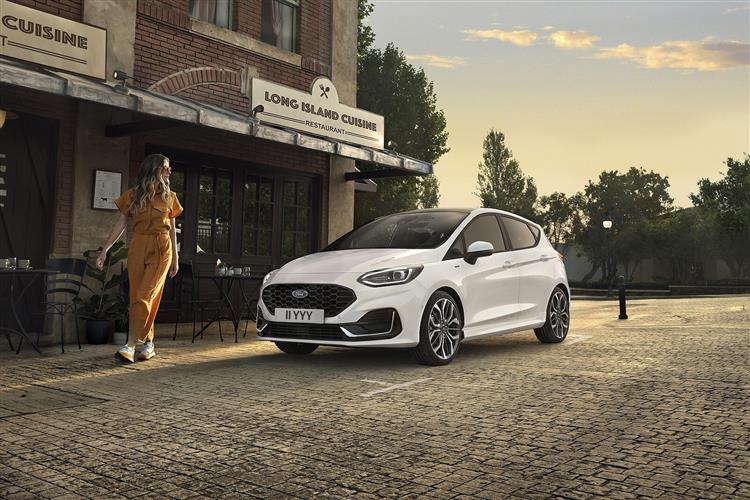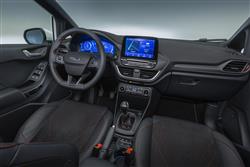How will you view?
This is a sample, showing 30 seconds of each section.
FINAL FIESTA (some text hidden) SECTIONED_new_fordfiesta_2022
By Jonathan Crouch
Introductionword count: 95
Ford's Fiesta has always been affordable and great to drive. But state of the art? It claimed to be that too in the improved take on the seventh generation model launched in late 2021. This turned out to be the very last Fiesta model before the line was discontinued from sale in mid-2024, but it certainly adds up as a decent used buy. Beneath the smarter styling lies some clever user-friendly technology - and cabin features that'll make down-sizing into one of these less of a chore. This is how you right a best seller.
Modelsword count: 12
[petrol] 1.1 Ti-VCT, 1.0 EcoBoost 100PS, 1.0 EcoBoost MHEV 125PS, 1.5 EcoBoost
Historyword count: 425
What's been the world's most significant car in the last half a century? This is our nomination, Ford's Fiesta, rejuvenated in MK7 model guise in 2017, then updated three years later with mild hybrid engines, before being facelifted in late 2021 for a fresh generation of buyers. All of which created the 2022 model year car we're going to look at here as a used buy. By late 2021 as Ford introduced what was to be this very final Fiesta (though we didn't know that then), the sales figures seemed to speak for themselves. Since this supermini had been first launched back in 1976, well over 17 million models had been sold, getting on for 5 million of them in the UK. Which is why, to keep up with demand, back at the end of this century's second decade, a Fiesta was still rolling off the Cologne production line every 68 seconds. By the time of this last model update though, demand for that level of production was starting to wane. In the UK, we had become no longer quite the nation of 'Fiesta folk' that we had previously been. Prior to 2021, for over three decades, this model line had been the UK's best seller but by the time of this last model update, it was being routinely out-sold by its Vauxhall Corsa arch-rival. Partly, that was down to Ford's more recent reticence when it came to slashing showroom pricing. And partly, it was down to the brand's reluctance to embrace the full electrification that by 2021 we were seeing in some segment rivals. This seventh generation model simply hadn't been engineered to work as a full-EV - or even as a full-Hybrid. But since 2020, more expensive 1.0-litre EcoBoost versions had had a less sophisticated mild hybrid system. Which worked particularly well with the brand's optional 7-speed Powershift dual clutch auto gearbox. For those who found that to be enough engine tech, then elsewhere with this supermini, Ford hoped that customers would find lots else to like with this fully facelifted version of the seventh generation design. Smarter styling included headlamps with full-LED tech. And pricier versions got the digital instruments and enhanced camera safety features that by 2021 we'd already seen in this model's almost identically-engineered SUV cousin, the Puma. As before, there was an 'Active' crossover version and an (enhanced) ST hot hatch variant. Plus as ever, this Fiesta delivered class leading drive dynamics. In this form, the Fiesta sold until the end of sales of this model line in mid-2024.
What You Getword count: 626
Ford resisted the temptation to meddle too much with the look of this seventh generation Fiesta when the powertrain line-up was substantially revised back in 2020. With this mid-term 2021 facelift though, a smarter, more sophisticated look arrived for the styling of European Design Director Joel Piaskowski's original shape. At the front, Fiesta regulars will immediately notice the way the reprofiled bonnet flows into slimmer headlamps. They have integrated daytime running lights, are of the full-LED variety on all variants and from new could be upgraded with Matrix technology featuring Glare-Free High Beam functionality. If you've owned an earlier-spec MK7 Fiesta, you might also pick up the fact that the Ford badge here has fallen from the nose to sit in the middle of a larger, bluffer and more overt grille, the style of which varies according to trim level. Move to the side and the changes made to this facelifted model are a lot more difficult to spot. Perhaps the most significant change was the deletion of the old three-door body style, which was surprising because previously, over 30% of customers had chosen it. The rear view isn't much different from the pre-2021-era model either. Ford was still limiting tail lamp LED tech to plusher models, this better emphasising the distinctive 'C'-shaped signature light pattern. What it all boils down to is that here, we got a facelift that made a real visual difference. At the wheel, you really will find the cabin of this post-2021-era Fiesta very different if your experience of this supermini is with older versions of it. What might be familiar though, is a choice of trim materials reminding you of this car's position at the budget end of Ford's model line-up. Perhaps aware of this, as part of the 2021 update, the Blue Oval brand introduced the 12.3-inch digital instrument screen we first saw in the Puma, which gave the front of the cabin a more sophisticated feel. Plus by 2021, luxury features like a Quickclear front windscreen and velour floor mats had been standardised across the range and the brand was trying to add a more premium feel to pricier versions - the red-stitched trimming of the plush 'ST-Line' variant for instance. As part of this update, an 8-inch SYNC centre-dash touchscreen was standard across the line-up and most models got it complete with navigation and the brand's clever 'FordPass Connect' built-in modem, which allows for in-car WiFi and remote interaction with your Fiesta via your smartphone. 'Apple CarPlay' and 'Android Auto' smartphone mirroring is of course included. And all the cabin basics were well executed: it's easy to find a comfortable driving position, the instruments are clear and there's plenty of interior storage. In the rear, as usual with a Fiesta, really tall folk will certainly need co-operation from those ahead to get truly comfortable in terms of leg space. Most buyers of course, will merely be carrying small children in the back - though even a youngster will only want to travel short distances in the middle of the rear bench as the cushion is quite narrow. Still, both outer seats feature load limiters and pre-tensioners (both features omitted on older generation Fiestas). Finally, let's take a look at the boot. We should give you the total cargo capacity figure - 292-litres; that's 41-litres less than you'd get in an EcoSport and about 20-30% less than you'd get in the most popular 'Juke'-genre small SUVs. If you need more room, pushing forward the 60:40-split rear backrest frees up 1,093-litres, which should be sufficient for the needs of most likely buyers. This Ford's floor has quite a step in it when the rear seats are tipped forward but you can alleviate this with the adjustable boot load floor.
To see the full road test text contact us on 0330 0020 227
Pictures (high res disabled)

.jpg)
|
.jpg)
|
.jpg)
| |||
.jpg)
|
.jpg)
|

|
Scoring (subset of scores)
Category: Small Runabouts
| Performance | |
| Handling | |
| Comfort | |
| Space | |
| Styling, Build, Value, Equipment, Depreciation, Handling, Insurance and Total scores are available with our full data feed. | |





